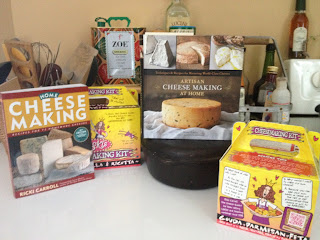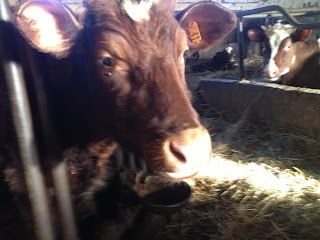 This past fall, I had the distinct honor of being chosen as one of just 240
US delegates to attend Slow Food’s 2014 Terra Madre & Salone del Gusto
global food conference in Turin, Italy.
This past fall, I had the distinct honor of being chosen as one of just 240
US delegates to attend Slow Food’s 2014 Terra Madre & Salone del Gusto
global food conference in Turin, Italy.Delegates from over 130 countries came together to talk about food and demonstrate their cultural traditions of agriculture, fishing, preserving, and cooking food, and to share their food movement success stories, challenges and lessons learned.
I sampled so many great foods from all over the world and, of course, coming from a cheese maker’s perspective, I naturally gravitated toward all the cheeses.
 |
| Shawn Saindon with Parmigiano-Reggiano |
I attended many cheese-related classes, tastings and
talks hosted by cheese makers and purveyors from different regions of the
world. Many of the cheeses discussed were officially inducted into The Ark of Taste, a Slow Food Foundation
for Biodiversity.
This project was created to draw attention to
certain foods and their possible extinction within the next few generations
either through modernization, lost traditions or through tightening health and
safety regulations.
These classes, as well as the entire Terra Madre
conference, gave me an amazing opportunity to speak directly with different food
producers and to get a real sense of the importance of biodiversity not just
within the cheese making world but within the overall food system as a whole.
For more information on the Ark of Taste project,
visit http://www.slowfoodfoundation.com/ark
So, I thought I would share with you a little about some of the cheeses I experienced. The following include some cheeses that I never really
knew existed if not for the Ark of Taste project and the Slow Food conference.
Turkmen
Fringe Cheese
An interesting cheese
that I completely fell in love with is called Turkmen Fringe Cheese. I stumbled upon this fantastic cheese at one
of the Slow Food tasting classes. This particular class was called The Cheeses and Wines of Turkey.
Its origins come from the cities of Kars and Ardahan
in the East Anatolia region of Turkey and dates back as far as the Ottoman
period.
Turkmen Fringe Cheese is normally made with non-fat
cow’s milk, although sometimes sheep’s milk is used. The milk is boiled with
the whey from the previous batch of cheese, acting as rennet. It is then boiled
until the milk curdles and then cooled down. The curds are kneaded and
stretched to create their string-like shape then stretched and rubbed continuously
with salt until it looks like spaghetti. It can be eaten fresh or preserved for
1-2 years.
Older traditions have the cheese pressed in animal
skins and buried underground to help with the development of molds.
 I found this cheese to be fantastic! It is odorless
and dry with a consistency of straw but when you eat it, it melts in your mouth
instantly into a sort of a milky mozzarella consistency. You can really taste
the milk, which is very important to me. Some people in the class found the
cheese to be too salty, due to the brine, but I found it to be a good balance
of flavors.
I found this cheese to be fantastic! It is odorless
and dry with a consistency of straw but when you eat it, it melts in your mouth
instantly into a sort of a milky mozzarella consistency. You can really taste
the milk, which is very important to me. Some people in the class found the
cheese to be too salty, due to the brine, but I found it to be a good balance
of flavors.
I could totally see kids loving Turkmen Fringe
Cheese as it is a good play on the concept of string cheese.
It surely was one of my favorite discoveries on this
trip and leaves me completely intrigued with the cheeses of Turkey.
Marayn
de Bartassac Cheeses –Southwest France
Lovers of an extremely strong, spicy and earthy flavor
will love appreciate these cheeses.
At the Terra Madre side of the food conference, this
booth was one of the more popular of the cheese related booths, mostly because
of the huge and gorgeous display of these ancient looking pucks of French cheeses.
They seriously were the cheese rock stars of the conference.
I’m talking about the cheeses of the micro-dairy Marayn
de Bartassac from the Gascony area of France.
They are based on ancient recipes that date as far
back as 1300 A.D., revived by philosopher and cheese guru, Hugh Lataste, along
with his wife and daughter.
I was told that there are around fifty varieties of
this cheese made from cow, sheep or goat milk. Most are a hard cheeses wrapped
in grape leafs and/or rubbed with spices and black pepper.
They were absolutely beautiful and the recipes to
make them are rich with traditions and history.
In all
honesty, I found these a bit too strong for my palate, since I tend to have a reaction
to some spicy, peppery foods, but I really appreciated the opportunity to try
something so different than any cheese I have ever encountered before.
Caciocavallo
 Finally, you couldn’t be at Salone Del Gusto and
Terra Madre, or in Italy, for that matter, without tasting some of the Italian
signature cheeses.
Finally, you couldn’t be at Salone Del Gusto and
Terra Madre, or in Italy, for that matter, without tasting some of the Italian
signature cheeses. Many great cheeses of the region were in attendance and I was constantly in a state of awe while being amongst them, such as Parmigiano-Reggiano, Mozzarella di Bufala (made with the milk from water buffalo) and Pecorino.
But the
handmade, stretched cheese, Caciocavallo, was one I had a lot of fun
discovering and it was everywhere!
Literally
translated, Caciocavallo means “cheese on horseback” and can be seen hanging,
with a rope around its neck, from a wooden dowel to drain and dry.
It hails from southern Italy and is usually made from cow’s milk but I also tried some made from buffalo and sheep’s milk.
It hails from southern Italy and is usually made from cow’s milk but I also tried some made from buffalo and sheep’s milk.
It’s
made similar to the way you would make and shape mozzarella but it is set in a brine
for a few days after being shaped. Then a string is tied around it and hung up
to dry and left to age for about two months before consuming.
It has a
rich and buttery flavor with a smooth texture. I especially loved how I really
could taste the most important part of the cheese - the milk!
There were many smoked varieties, as well, and some even were embedded with a ‘gem’.
These special treats are called Riavulilli (little devil). While this cheese is being shaped, the cheese maker inserts a black olive, a piece of citrus fruit or even a piece of cured pepperoni into the stretched curd. The cheese's head is then formed and tied, usually, with a piece of vegetable fiber rope called raffia.
There were many smoked varieties, as well, and some even were embedded with a ‘gem’.
These special treats are called Riavulilli (little devil). While this cheese is being shaped, the cheese maker inserts a black olive, a piece of citrus fruit or even a piece of cured pepperoni into the stretched curd. The cheese's head is then formed and tied, usually, with a piece of vegetable fiber rope called raffia.
Final
Thoughts
There were so many amazing offerings presented at
Terra Madre & Salone Del Gusto that these few cheeses I mentioned in this
post were only the tip of the ice berg.
It was inspiring to me to see such cheese making traditions continuing on to future generations. It was also an eye opening experience for me to see the important role that diversity plays in cheese making and our food system as a whole.
It was inspiring to me to see such cheese making traditions continuing on to future generations. It was also an eye opening experience for me to see the important role that diversity plays in cheese making and our food system as a whole.
Finally, I would like to give a heartfelt thanks
to everyone who have supported me and helped me to attend this important,
educational conference. This trip couldn’t have happened without you. Thank
you!
#salonedelgusto #newenglandcheesemaking #SlowfoodUSA #slowfoodinternational #winterhillfarm #portlandME
Visit my Facebook pages! Of Song and Cheese
#salonedelgusto #newenglandcheesemaking #SlowfoodUSA #slowfoodinternational #winterhillfarm #portlandME
Visit my Facebook pages! Of Song and Cheese
Need supplies for home cheese making? I always recommend the New England Cheesemaking Supply Co.




















